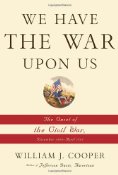
We Have The War Upon Us By William J. Cooper
 We Have The War Upon Us
We Have The War Upon Us
The Onset of the Civil War, November 1860-April 1861
By William J. Cooper
In the Preface to his book Cooper discusses the historians’ job. He turns to one of the most influential conservative historians of the 20th century, David M. Potter to explain: “’The supreme task of the historian and the one of most superlative difficulty, is to see the past through the imperfect eyes of those who lived it, and not with his own omniscient twenty-twenty vision.’ Recognizing the arduousness of his assigned task, Potter concluded, ‘I am not suggesting that any of us can really do this, but only that it is what we must attempt.’â€
Cooper adheres to Potter’s charge with this exhaustively researched book. He begins, appropriately, by laying out the political and cultural milieu in which the events occurred.
He examines the five-month prelude to the Civil War and concludes that, contrary to what most Americans today believe, although the war ended slavery it was not begun for that reason.
“In the mid-nineteenth century almost all white Americans and Western Europeans believed in the supremacy of the white race.†The author adds a note to readers who may draw unfounded conclusions about the author from that statement: “I will not keep pointing out that this outlook is different from mine and that of our own era. I should not need to.â€
Among white southerners the prevailing view, at least from the revolutionary period, was that there was no contradiction between their faith in liberty and the existence of slavery. In fact, white southerners defined liberty as encompassing their right to own slaves and to determine the fate of the institution.
For Republicans of the time, political considerations dictated that ending slavery, as a justification for war, would not garner united northern support and could quite possibly destroy their party. Cooper focuses on the influence of partisan politics during these fateful months.
The maneuvering for leverage and jockeying for power taking place within the newly ascendant Republican party mirrored the struggle taking place within the country. “All Republicans rejoiced in what Salmon Chase termed ‘the overthrow of the slave power.’ They congratulated themselves that Lincoln’s victory signified the slipping away of the massive influence the South had wielded over the national government.â€
Congressman Charles Francis Adams (son of John Quincy Adams and grandson of John Adams), “perceptively identified the powerful southern reaction to the Republican triumph dramatized in the sectional clash. ‘The question is one of power,’ he avowed. Recognizing political power in the nation as the central issue, Adams identified its loss as the South’s ‘only true grievance.’ The South, as he so aptly put it, ‘want[ed] to continue to rule.’ Adams could perceive no effective palliative, for, in his judgment, ’the true difficulty is incurable.’ The South had already fallen behind in population and economic might and now could not match the North in political strength. To Adams this shift in national power ‘doomed’ the South because it had forever lost its primacy.â€
Lincoln’s election ended Southern domination over the federal government that had prevailed since the Founding. “Never before in American History had a party with no southern connection won a national election.†Lincoln won 180 electoral votes, but none in the fifteen slave states. He received only 39.8 percent of the popular vote, and no votes from the ten slave states. No previous candidate had won with such a small percentage of the popular vote.
Republicans had never before elected a president. They had never controlled Congress. The Republicans owed their victory to the split at the Democrat national convention along North-South lines over the issue of slavery in the territories. Following Lincoln’s victory, the dispirited Democrats had to find a way to reunite their party.
The siren call of southern secessionists was that the only way to save their party and their way of life from Republican tyranny was to form a separate and independent confederacy. Yet, if the secessionists were successful in extracting the slave states, the Democrat Party would be devastated. Their numbers in Congress would dwindle and any hope of winning back the presidency would disappear.
The Democrats were not powerless, for along with northern Democrats they dominated the Senate and were powerful in the House. In addition they could count on the Supreme Court and the federal judiciary. In summary, the South had to decide what Republican control of the executive might mean, whether it would result in an inability to protect the region’s vital interests.
Before Lincoln even took office nine slave states were debating whether to stay in a union dominated by Republicans. Lincoln, desiring to make a conciliatory gesture, wanted to appoint some Democrats to his cabinet but did not know if any would agree to serve.
Americans, Lincoln among them, overwhelmingly believed that the Constitution protected slavery in the states where it existed. The dividing issue was whether slavery would be allowed in the national territories. If the South was to remain politically viable, it needed to keep pace with the expansion of the free states.
Charles C. Kesler argues in his writings on the Constitution that, whatever the popular views at the time of the Founding, the signers of the Constitution who were slaveholders knew that slavery was morally wrong. What to do about it and when to do it was the issue they could not resolve. Instead, they, and those who followed during the succeeding three-quarters of a century, fashioned one compromise after another in attempts to reconcile the Declaration of Independence affirmation that “all men are created equal,†with political exigencies.
Many in 1861 believed that Congress would somehow fashion another compromise. Americans favoring compromise existed in both parties and among both antislavery and proslavery men. The sentiment was particularly strong among northern Democrats in the Upper South and Border who saw secession as putting them in an untenable position. But neither the House nor Senate, despite committees convened for that purpose, could overcome sectional divisions.
“For three months this Congress had had the fate of the Union in its hands,” Cooper writes. “After witnessing the secession of seven states, leaving the Union broken, [Congress] could not find the will or the way to take positive action … The great American political tradition of compromise stemming from the Constitutional Convention of 1787 had foundered.”
President James Buchanan, sympathetic to the South but unwilling to see the Union ruptured, vacillated and then attempted to placate secessionist South Carolina by making an agreement with Gov. Francis Pickens that he would not reinforce Fort Sumter in Charleston Harbor if the state did not attempt to take the fort by force. His efforts delayed, but did not resolve the problem of federal holdings in secessionist states.
Not all Americans wanted compromise. At the political extremes were radical southern secessionists who saw the election of a northern president as an opportunity to disrupt the Union. Equally adamant, a triumphant contingent of Republicans in the North rejected any compromise, as did hard line abolitionists.
This book is about the men whose decisions, action or inaction during those fateful five months culminated in the Civil War.
Kentucky Sen. John Crittenden played a leading role among those who tried to avoid a fractured Union as did Illinois Sen. Stephen Douglas, Mississippi Sen. Jefferson Davis, (who counseled patience and conciliation unless threatened with coercion), and most particularly William Seward, President-elect Lincoln’s choice for secretary of state. Seward worked tirelessly to bridge the schism between North and South. If anyone emerges a hero from these cataclysmic months it is Seward, consummate politician, statesman and patriot who risked reputation and position to try to hold the Union together, while still remaining loyal to Lincoln.
Seward feared the country was in real danger of coming apart, a view Lincoln did not share. Lincoln thought of southerners as fellow Americans and initially dismissed threats of succession as campaign rhetoric that would soon dissipate. Urged by Seward and others to make some statement to allay Southern fears, he refused. Once in office he would prove to the South that they had no cause for alarm. Lincoln was not averse to compromise; he supported an amendment to the Constitution protecting slavery, in perpetuity, in the states where it already existed, and another protecting the rights of slaveholders to reclaim runaways.
Lincoln hated slavery but he would abide by the Constitution. However, on the core issue of the extension of slavery in the territories he would not bend.
The implications Cooper draws from his research are controversial. He takes issue with Lincoln’s intransigence, describing Lincoln as “inflexible†and “tone deaf†to southern concerns. The author forwards the thoughts that population and geographic growth plus the economic power of the free states would have condemned slavery to oblivion. Had Lincoln been conciliatory in his inaugural address or before, the secession of the seven Deep South states and all that ensued might have been prevented.
In fact, this book is replete with “what might have beens†if only the players in this national tragedy had behaved differently. However, as Cooper writes in the Preface, no one could have known where their decisions would lead just as no one could foresee the length and horrors of the war.
This is an engrossing book, full of fascinating historical details. It is essential reading for anyone interested in the American Civil War and an excellent introduction to the people and events that led up to the bloodiest, most devastating war in American history.
Cooper focuses on why the pro-compromise forces lost, or stated another way, why the American tradition of sectional compromise failed and we had “the war upon us.â€
 The posts are coming!
The posts are coming!

0 comments
Kick things off by filling out the form below.
Leave a Comment